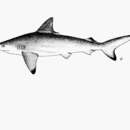Diagnostic Description
provided by Fishbase
Grey above, white below, with the tips of the pectorals, and upper and lower caudal-fin lobes black; other fins dusky (Ref. 9997).
- Recorder
- Cristina V. Garilao
Life Cycle
provided by Fishbase
Distinct pairing with embrace (Ref. 205). Viviparous, placental (Ref. 50449).
Migration
provided by Fishbase
Amphidromous. Refers to fishes that regularly migrate between freshwater and the sea (in both directions), but not for the purpose of breeding, as in anadromous and catadromous species. Sub-division of diadromous. Migrations should be cyclical and predictable and cover more than 100 km.Characteristic elements in amphidromy are: reproduction in fresh water, passage to sea by newly hatched larvae, a period of feeding and growing at sea usually a few months long, return to fresh water of well-grown juveniles, a further period of feeding and growing in fresh water, followed by reproduction there (Ref. 82692).
- Recorder
- Kent E. Carpenter
Morphology
provided by Fishbase
Dorsal spines (total): 0; Dorsal soft rays (total): 0; Analspines: 0; Analsoft rays: 0
- Recorder
- Cristina V. Garilao
Trophic Strategy
provided by Fishbase
A little-known shark found on the continental and insular shelves. Reports from river mouths and rivers are based on old records that need verification. Probably feeds on small fishes, cephalopods, and crustaceans.
- Recorder
- Drina Sta. Iglesia
Biology
provided by Fishbase
A little-known shark found on the continental and insular shelves (Ref. 244). Reports from river mouths and rivers are based on old records that need verification (Ref. 9997). Probably feeds on small fishes, cephalopods, and crustaceans (Ref. 9997). Viviparous (Ref. 50449). Utilized fresh for human consumption (Ref. 9997).
- Recorder
- Kent E. Carpenter
Importance
provided by Fishbase
fisheries: subsistence fisheries
- Recorder
- Kent E. Carpenter

